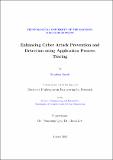| dc.contributor.advisor | Qiao, Yuansong | |
| dc.contributor.advisor | Lee, Brian | |
| dc.contributor.author | Jacob, Stephen | |
| dc.date.accessioned | 2022-12-20T12:12:27Z | |
| dc.date.available | 2022-12-20T12:12:27Z | |
| dc.date.copyright | 2022 | |
| dc.date.issued | 2022-08 | |
| dc.identifier.citation | Jacob, S. (2022). Enhancing cyber attack prevention and detection using application process tracing. Thesis (Doctor of Philosophy - PhD). Technological University of the Shannon: Midlands Midwest. | en_US |
| dc.identifier.uri | https://research.thea.ie/handle/20.500.12065/4347 | |
| dc.description.abstract | Nowadays, software enterprises are being targeted by more advanced cyber-security
threat models. Consequently, more sophisticated means of protecting software organisa tions are in high demand. Also, microservices are trending for being amongst the most
popular software application design architecture. The aim of this thesis is to explore
how application process tracing can be applied to enhance cyber-attack prevention and
detection.
We propose two objectives for this research project. The first objective is to observe how
the prediction of future events in an application thread can help identify potential targets
and thus enable cyber-security personnel to take proactive defensive measures. This
approach is valid for general business application processes. The second objective is to
investigate how anomaly detection approaches can be applied to microservice application
process tracing and detect seeded cyber-attacks.
One approach for addressing the first objective is to employ a machine learning model
to learn general business application processes and functionality to provide a contextual
oversight of the process application’s infrastructure. This can be done by applying
process mining to observe the execution paths of application processes. An alternative
method is to employ a deep learning model to discover the contextual oversight of the
application process. We trained a Long Short Term Memory (LSTM) model to learn
the sequential dependencies for existing processes and subsequently made predictions in
ongoing process instances with the aim of improving cyber situational awareness.
For addressing our second objective, we considered microservice application process
tracing. The functionality of a microservices application can be monitored and logged
using distributed tracing. Anomaly detection is defined as the discovery of irregular
instances or patterns within a data series. To detect cyber-attacks in a microservices
application, frequency distribution-based anomaly detection was performed to identify
irregular microservice application activity within a synthetic data set of traces. This
machine learning model was tested by simulating a brute force password guessing attack
against the application.
To further address the second objective, the traffic of a microservices application can also
be modelled using graph theory and anomaly detection techniques can also be applied
to this model. In the last stage of our research, we trained a Diffusion Convolutional
Recurrent Neural Network (DCRNN) using synthetic data sets of distributed traces to
learn both the spatial and temporal dependencies of the data. Subsequently, we made
predictions of microservice activity using traffic forecasting and applied threshold-based anomaly detection to detect injected cyber-security attacks. The different cyber-attacks
emulated in the testing data to evaluate this model include a brute force attack, a batch
registration of bot accounts and a distributed denial of service attack. | en_US |
| dc.format | PDF | en_US |
| dc.language.iso | eng | en_US |
| dc.publisher | Technological University of the Shannon: Midlands Midwest | en_US |
| dc.rights | Attribution-Non-Commercial-Share-Alike-3.0 United States | * |
| dc.rights.uri | http://creativecommons.org/licenses/by-nc-sa/3.0/us/ | * |
| dc.subject | Cyber security | en_US |
| dc.subject | Cyber attack prevention | en_US |
| dc.subject | Application process tracing | en_US |
| dc.title | Enhancing cyber attack prevention and detection using application process tracing | en_US |
| dc.type | info:eu-repo/semantics/doctoralThesis | en_US |
| dc.contributor.affiliation | Technological University of the Shannon: Midlands Midwest | en_US |
| dc.description.peerreview | yes | en_US |
| dc.identifier.orcid | https://orcid.org/0000-0003-2297-4343 | en_US |
| dc.rights.accessrights | info:eu-repo/semantics/openAccess | en_US |
| dc.subject.department | Faculty of Engineering and Informatics: TUS Midlands | en_US |


